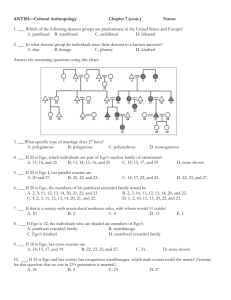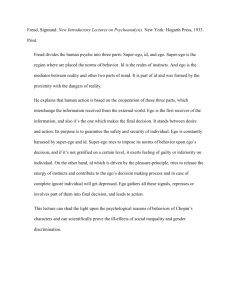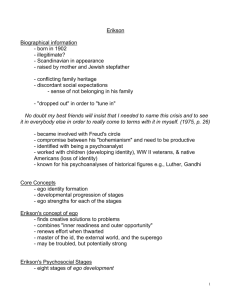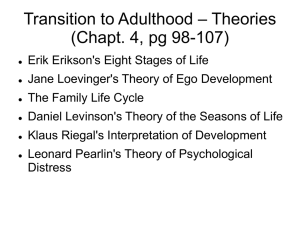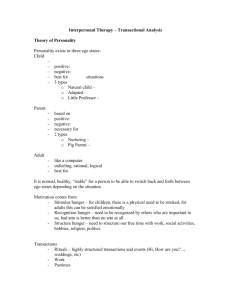Application of Transactional Analysis in ESL/EFL Listening and Speaking Published By
advertisement
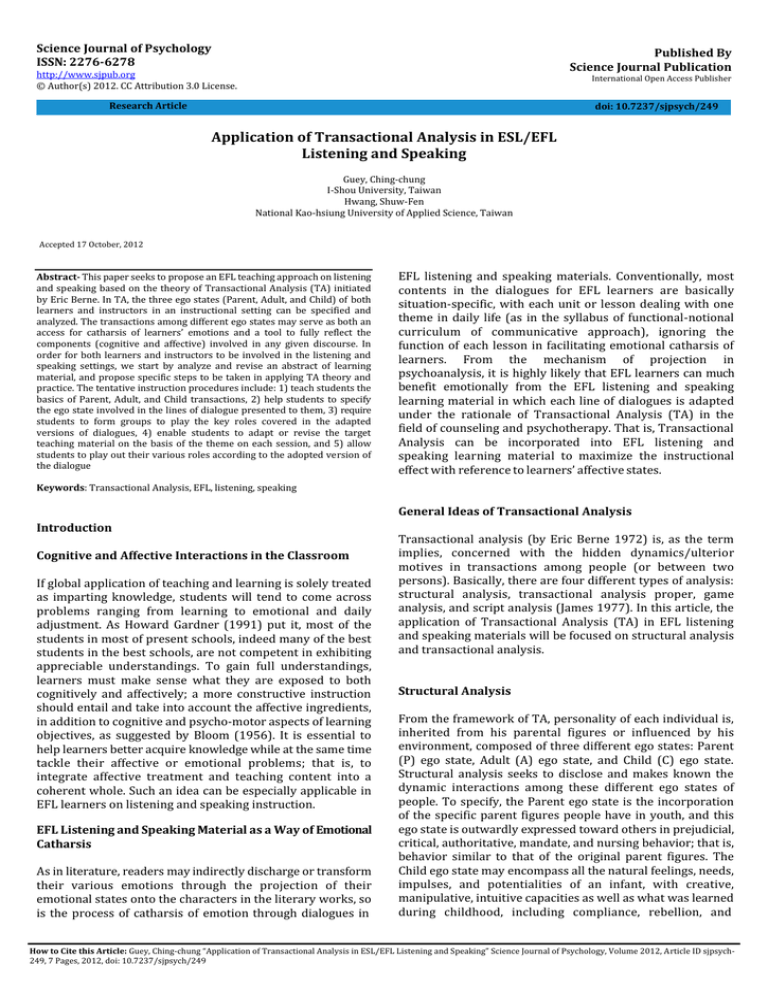
Science Journal of Psychology ISSN: 2276-6278 Published By Science Journal Publication http://www.sjpub.org © Author(s) 2012. CC Attribution 3.0 License. International Open Access Publisher Research Article doi: 10.7237/sjpsych/249 Application of Transactional Analysis in ESL/EFL Listening and Speaking Accepted 17 October, 2012 Guey, Ching-chung I-Shou University, Taiwan Hwang, Shuw-Fen National Kao-hsiung University of Applied Science, Taiwan Abstract- This paper seeks to propose an EFL teaching approach on listening and speaking based on the theory of Transactional Analysis (TA) initiated by Eric Berne. In TA, the three ego states (Parent, Adult, and Child) of both learners and instructors in an instructional setting can be specified and analyzed. The transactions among different ego states may serve as both an access for catharsis of learners’ emotions and a tool to fully reflect the components (cognitive and affective) involved in any given discourse. In order for both learners and instructors to be involved in the listening and speaking settings, we start by analyze and revise an abstract of learning material, and propose specific steps to be taken in applying TA theory and practice. The tentative instruction procedures include: 1) teach students the basics of Parent, Adult, and Child transactions, 2) help students to specify the ego state involved in the lines of dialogue presented to them, 3) require students to form groups to play the key roles covered in the adapted versions of dialogues, 4) enable students to adapt or revise the target teaching material on the basis of the theme on each session, and 5) allow students to play out their various roles according to the adopted version of the dialogue Keywords: Transactional Analysis, EFL, listening, speaking Introduction Cognitive and Affective Interactions in the Classroom If global application of teaching and learning is solely treated as imparting knowledge, students will tend to come across problems ranging from learning to emotional and daily adjustment. As Howard Gardner (1991) put it, most of the students in most of present schools, indeed many of the best students in the best schools, are not competent in exhibiting appreciable understandings. To gain full understandings, learners must make sense what they are exposed to both cognitively and affectively; a more constructive instruction should entail and take into account the affective ingredients, in addition to cognitive and psycho-motor aspects of learning objectives, as suggested by Bloom (1956). It is essential to help learners better acquire knowledge while at the same time tackle their affective or emotional problems; that is, to integrate affective treatment and teaching content into a coherent whole. Such an idea can be especially applicable in EFL learners on listening and speaking instruction. EFL Listening and Speaking Material as a Way of Emotional Catharsis As in literature, readers may indirectly discharge or transform their various emotions through the projection of their emotional states onto the characters in the literary works, so is the process of catharsis of emotion through dialogues in EFL listening and speaking materials. Conventionally, most contents in the dialogues for EFL learners are basically situation-specific, with each unit or lesson dealing with one theme in daily life (as in the syllabus of functional-notional curriculum of communicative approach), ignoring the function of each lesson in facilitating emotional catharsis of learners. From the mechanism of projection in psychoanalysis, it is highly likely that EFL learners can much benefit emotionally from the EFL listening and speaking learning material in which each line of dialogues is adapted under the rationale of Transactional Analysis (TA) in the field of counseling and psychotherapy. That is, Transactional Analysis can be incorporated into EFL listening and speaking learning material to maximize the instructional effect with reference to learners’ affective states. General Ideas of Transactional Analysis Transactional analysis (by Eric Berne 1972) is, as the term implies, concerned with the hidden dynamics/ulterior motives in transactions among people (or between two persons). Basically, there are four different types of analysis: structural analysis, transactional analysis proper, game analysis, and script analysis (James 1977). In this article, the application of Transactional Analysis (TA) in EFL listening and speaking materials will be focused on structural analysis and transactional analysis. Structural Analysis From the framework of TA, personality of each individual is, inherited from his parental figures or influenced by his environment, composed of three different ego states: Parent (P) ego state, Adult (A) ego state, and Child (C) ego state. Structural analysis seeks to disclose and makes known the dynamic interactions among these different ego states of people. To specify, the Parent ego state is the incorporation of the specific parent figures people have in youth, and this ego state is outwardly expressed toward others in prejudicial, critical, authoritative, mandate, and nursing behavior; that is, behavior similar to that of the original parent figures. The Child ego state may encompass all the natural feelings, needs, impulses, and potentialities of an infant, with creative, manipulative, intuitive capacities as well as what was learned during childhood, including compliance, rebellion, and How to Cite this Article: Guey, Ching-chung “Application of Transactional Analysis in ESL/EFL Listening and Speaking” Science Journal of Psychology, Volume 2012, Article ID sjpsych249, 7 Pages, 2012, doi: 10.7237/sjpsych/249 Page 2 Science Journal of Psychology (ISSN: 2276-6278) procrastination. The Adult ego state is conceived a s the autonomous collecting, data processing, and estimating possibility as a basis of taking action. The structure of personality can be illustrated by Figure 1 below. Fig. 1 Three Ego States with Their Individual Contents and Acronyms From Figure 1, when people are in the Parent ego state, they act, think, or feel as their parent figures once did; when people are in the Adult ego state, they are rational, objective, and collecting data/facts, computing/processing them, and acting on the basis of facts, rather than on the basis of parental tradition or childhood feelings; when people are in the Child ego state, they feel, act, and respond to others as they learned to do when they were young, being rebellious, procrastinating, teasing others, and being compliant or naughty. To take the dialogue below as an example, each line of the two interlocutors can be analyzed and specified in terms of the Parent, Adult, and Child ego states. Tim: Alan, do you want to see the pictures of my holiday in Italy? Adult Ego State (a plain question without emotion) Alan: Why was the traffic horrible? Adult Ego State (seeking information) Tim: Those Italians are crazy drivers! I don't want to think about it! Child Ego State (expression with strong emotions) Alan: OK, OK, let's return to the good parts ... Parent Ego State (imperative statement starting with ‘Let’s’) Tim: Yes, so here's a picture of the Leaning Tower of Pisa. Adult Ego State (a sheer statement of a fact) Alan: Sure, what was it like? Alan: Incredible! Tim: Ah, the holiday was great! The food was great! The wine was great! The traffic was horrible! Tim: It was raining that day, but it was still wonderful. We climbed to the top! Adult Ego State (seeking information) Child Ego State (expression with heightened emotions) Child Ego State (expression with strong emotions) Adult Ego State (plain description of a fact) How to Cite this Article: Guey, Ching-chung “Application of Transactional Analysis in ESL/EFL Listening and Speaking” Science Journal of Psychology, Volume 2012, Article ID sjpsych249, 7 Pages, 2012, doi: 10.7237/sjpsych/249 Page 3 Alan: And what's this? Adult Ego State (seeking information) Tim: That's a photo of the Arno River, in Florence. Adult Ego State (plain description of a fact) Verbal and Nonverbal Clues of Different Ego States There are many clues to help identifying stimulus and response as Parent, Adult, or Child. These include not only the words used but also the tones of voice, body gestures, and facial expressions. The more skillful we become in picking up these clues, the more data we acquire in Transactional Analysis. We do not have to dig deep into anecdotal material in the past to discover what is recorded in Parent, Adult, and Child. We disclose and reveal what we ourselves are and do today. The following is the description of physical and verbal clues for each ego state. Parent Clues Physical: furrowed brow, pursed lips, the pointing index finger, head-wagging, the “horrified look,”, arms folded across chest, tongue-clucking, sighing, patting another on the head. These are typical Parent gestures. However, there may be other Parent gestures peculiar to one’s own Parent. For instance, if a teacher has a habit of clearing his throat and looking skyward each time he is to make a pronouncement about students’ bad behaviors, this mannerism would, beyond doubt, be your own prelude to a Parent statement, even though not generally seen as Parent in most teachers. Also, there are cultural differences. For instance, in Taiwan (as in America) teachers normally exhale as they sigh, whereas in some European countries (such as Sweden) they inhale as they sigh. Verbal: expressions such as “I am going to put a stop to this once and for all”; “I can’t allow the life of me…”; “Now always remember…”; (‘‘always,” “never,” “should,” and “must” are almost always Parent words, which may fend off new data input); “How many times have I told you?” “If I were you…” Many evaluative words, whether critical or supportive, may identify the Parent as they make a judgment about another, based not on Adult evaluation but on automatic response. Examples of evaluative/critical words are: stupid, naughty, ridiculous, disgusting, shocking, asinine, lazy, nonsense, absurd, poor thing, poor dear, no! Evaluative sentences are: “How dare you?” “Now what?” “Not again!” Yet, please note that the use of these words can be taken together with body gestures and the context of the transaction to help identify the Parent ego state. Child Clues Physical: the following signal the involvement of the Child ego state in a transaction: tears; the quivering lip; temper tantrums; the high-pitched, whining voice; shrugging Science Journal of Psychology (ISSN: 2276-6278) shoulders; downcast eyes; teasing; delight; laughter; nailbiting; nose-thumbing; squirming; and giggling. Verbal: many expressions can help identify the Child ego state: I wish, I want, I gonna, I don’t care, I guess, biggest (all the possible superlatives). In addition, words such as why, what, where, who, when, and how are used often by little children, and are not clues to the Child, but clues to the adult operating in the little person. Adult Clues Physical: the Adult face is straightforward. If the head is tilted, the person is listening with an angle in mind. Verbal: the basic vocabulary of the Adult consists of why, what, where, when, who, and how. Other words are: how much, in what way, comparative, true, false, probable, possible, unknown, objective, I think, I see, it is my opinion, etc. These words all indicate adult data processing. In the phrase “it is my opinion,” the opinion may be derived from the Parent ego state, but the statement is Adult for it is identified as an opinion, not a fact. “It is my opinion that high school students should stay away from politics” (Adult like expression) is not the same as the statement “High school students should stay away from politics.” (Parent like expression) Dialogues Expressed in Three Ego States Most of the teaching materials used in listening and speaking can be adapted into a new version where the lines of dialogue can be made to fit into Parent, Adult, or Child expressions. That is, dialogue of Adult expression can be adapted into either Parent expression or Child expression (so is Parent and Child expressions rewritten to be the expressions of the other ego states) to expand learners’ span of awareness of the usage of dialogues as well as the ego states involved, which may help promote emotional catharsis, and consolidate what is learned. The following is a tentative adaptation of a Reading dialogue (A Holiday in Italy by Kenneth Beare) in terms of three ago states, and it is, no doubt, subject to change. (English teachers can make necessary revision on the basis of their individual needs) Reading Dialogue: A Holiday in Italy (two friends looking at pictures of a holiday) Original Version: 1. Tim: Alan, do you want to see the pictures of my holiday in Italy? Alan: Sure, what was it like? 2. Tim: Ah, the holiday was great! The food was great! The wine was great! The traffic was horrible! Alan: Why was the traffic horrible? How to Cite this Article: Guey, Ching-chung “Application of Transactional Analysis in ESL/EFL Listening and Speaking” Science Journal of Psychology, Volume 2012, Article ID sjpsych249, 7 Pages, 2012, doi: 10.7237/sjpsych/249 Page 4 3. Tim: Those Italians are crazy drivers! I don't want to think about it! Alan: OK, OK, let's return to the good parts ... 4. Tim: Yes, so here's a picture of the Leaning Tower of Pisa. Alan: Incredible! 5. Tim: It was raining that day, but it was still wonderful. We climbed to the top! Alan: And what's this? 6. Tim: That's a photo of the Arno River, in Florence. Adapted Version: Dialogue Transaction 1 Tim: Alan, do you want to see the pictures of my holiday in Italy? Alan, do you want to see the pictures of my holiday in Italy? Adult Ego State (a plain question without emotions involved) Alan, come to see the pictures of my holiday in Italy. Parent Ego State (with an imperative tone) Alan, it will be great if you come to see the pictures of my holiday in Italy. Child Ego State (statement with emotional feeling-(great) Alan: Sure, what was it like? Sure, what was it like? Adult Ego State (seeking information) Sure, why not? Parent Ego State (with an interrogative tone) You are not joking, are you? Chile Ego State (tease like question statement) Dialogue transaction 2 Tim: Ah, the holiday was great! The food was great! The wine was great! The traffic was horrible! Ah, the holiday was great! The food was great! The wine was great! The traffic was horrible! Science Journal of Psychology (ISSN: 2276-6278) Child Ego State (statement with emotional feeling-(great) Believe me, the holiday, the food, the wine were all good, but, not the traffic. Parent Ego State (with an imperative tone and criticism) Well, the holiday was well organized, with good food, and wine, but the traffic was not as good! Adult Ego State (statement of an opinion without emotions) Alan: Why was the traffic horrible? Why was the traffic horrible? Adult Ego State (seeking information) Tell me why the traffic was horrible? Parent Ego State (with an interrogative tone) Oh! Please tell me why the traffic was horrible. Child Ego State (with a tone of submissive request) Dialogue Transaction 3 Tim: Those Italians are crazy drivers! I don't want to think about it! Those Italians are crazy drivers! I don't want to think about it! Child Ego State (with a tone of complaint) Those Italians should be heavily fined! They don't follow the rules! Parent Ego State (parental “should”) Those Italian drivers do not follow traffic regulations! Adult Ego State (a plain statement of a fact) Alan: OK, OK, let's return to the good parts ... OK, OK, let's return to the good parts ... Parent Ego State (with an interrogative tone of “let’s”) Then we may talk about other parts ... Adult Ego State (a plain statement of a suggestion) Yes, I would like to hear the good parts. Child Ego State (a statement of a desire) How to Cite this Article: Guey, Ching-chung “Application of Transactional Analysis in ESL/EFL Listening and Speaking” Science Journal of Psychology, Volume 2012, Article ID sjpsych249, 7 Pages, 2012, doi: 10.7237/sjpsych/249 Page 5 Dialogue Transaction 4 Tim: Yes, so here's a picture of the Leaning Tower of Pisa. Science Journal of Psychology (ISSN: 2276-6278) And tell me what it is. Parent Ego State (with an imperative tone) Yes, so here's a picture of the Leaning Tower of Pisa. Wow, please look at that, what is it? Of course, see the picture of the Leaning Tower of Pisa here. Dialogue Transaction 6 Adult Ego State (a plain statement of a fact) Parent Ego State (with an imperative tone of request) Yes, can you imagine the terrific picture of the Leaning Tower of Pisa here? Child Ego State (a child like exclamation) Tim: That's a photo of the Arno River, in Florence. That's a photo of the Arno River, in Florence. Child Ego State (a child like question statement) Adult Ego State (a plain statement of a fact) Alan: Incredible! Well, I won’t tell you unless you beg me…… Child Ego State (a child like exclamation) Child Ego State (a child like expression) Incredible! It is impressive. Adult Ego State (a plain statement of impression) Not bad at all, don’t you think so? Parent Ego State (an evaluative statement) Dialogue Transaction 5 Tim: It was raining that day, but it was still wonderful. We climbed to the top! It was raining that day, but it was still wonderful. We climbed to the top! Adult Ego State (a plain statement of a fact) Listen! It was raining that day, but it was still wonderful. We climbed to the top! Parent Ego State (with an imperative tone) You won’t believe it, it was raining that day, but it was still wonderful. Guess what? We even climbed to the top! Child Ego State (a child like statement of “Guess what?) Alan: And what's this? And what's this? Adult Ego State (a plain question statement to seek information) It is a photo of the Arno River, in Florence. Don’t you know that? It's a photo of the Arno River, in Florence. Parent Ego State (parental interrogation) The adapted versions offer students more freedom and opportunities in their expression of ideas (Adult state) or emotions (Parent or Child state), which may greatly reduce the boredom of exercising drills and promote students’ motivation via the liveliness of various dialogue formats. In addition, students may also change (shift) their ego states (among Parent, Adult, or Child) as the situations require or as their wish). In real life situations, shifts in ego states can be observed in all people. And the adaptation of the dialogue from original format to various other formats is a sheer reflection of the reality. It is believed that if students are given the chance to experience the three ego states (i.e., Parent, Adult and Child) in various situations, they will be more able to discharge their emotions (either positive or negative), gain more in depth awareness of their transactions with other people in daily life, thus facilitating the more complete understanding about the teaching material per se. Obviously, one of the purposes of adapting listening and speaking teaching material in terms of three ego states is to combine emotional discharge (catharsis) with language input (learning) and deal with them at the same time. Procedures of Instruction Teachers who adopt the integrative version of dialogue involving three versions of ego states may start from teaching students the basic concepts and nature of the Parent, Adult, and Child ego states, and then ask students to identify each of the ego states involved as they hear or speak a certain line of words in a dialogue. After all the students have a clear picture about each of the ego states, teachers may further ask students to form various groups for role playing in accordance with the How to Cite this Article: Guey, Ching-chung “Application of Transactional Analysis in ESL/EFL Listening and Speaking” Science Journal of Psychology, Volume 2012, Article ID sjpsych249, 7 Pages, 2012, doi: 10.7237/sjpsych/249 Page 6 Science Journal of Psychology (ISSN: 2276-6278) adapted version of the teaching material. Note that students may be required to shift the roles among Parent, Adult, and Child ego states. This step will help broaden their self awareness in different interpersonal contexts during their role playing. For each new session, students are required to adapt a given material in terms of the three ego states on their own, and then conduct the role play session. Since there is a definite theme for each dialogue, adapting dialogues can thus be made flexible according to each individual theme. In sum the tentative instruction procedures can be briefly specified below: 1. 2. 3. 4. 5. Teach students the basics of Parent, Adult, and Child transactions Help students to specify the ego state involved in the lines of dialogue presented to them Require students to form groups for role playing on the adapted versions of dialogues Enable students to adapt or revise the target teaching material on the basis of the theme on each session Allow students to play out their various roles according to the adopted version of the dialogue The steps listed above are anything but exhaustive, so interested teachers can always elaborate on the activities as the instruction settings require. Note that the model introduced here can also be applied to class management other than course learning. For one thing, if there is an argument or conflict among students in class, the teacher can first ask the students involved to identify and specify their exact ego states of what they actually said and acted, and then require them to change the ego states (normally from Parent or Child to Adult) and re-say the words accordingly. See the virtual dialogues below: Teacher: John, what is wrong with you? Student 1: Peter always calls my names. I cannot stand it. He is an asshole. Teacher: Now Peter, please identify what you have just said. Is it Parent, Adult, or Child? Student 1: Oh, I guess it is Child. Teacher: Can you say it again in terms of your Adult? Student 1: Well, I would say… Peter sometimes call me something I do not like…I feel unhappy about it. I hope he will not do it again.……. As indicated by Eric Berne (1972), most of arguments/conflicts or any negative emotions are basically stimulated by words from one’s Parent or Child ego states. Thus, one of the solutions to the problem is to help strengthen the Adult ego states in both parties. How to Help Students Stay in the Adult in Class From the definition of our three ego states, the Adult develops later than the Parent and the Child and seems to be a challenging learning task throughout life. As people stay long enough in their childhood surrounded by what is said and done by their Parents or Parent figures (i.e., Parent in general), the Parent and Child tend to emerge spontaneously and automatically in response to stimuli. The first step, therefore, to build the strength of the Adult is to become sensitive to Parent and Child signals. For one thing, the aroused feelings are in most cases a clue that the Child has been hooked, and when the feelings (normally negative) appear, counting to ten is an effective way to delay the automatic response for the Adult to control the transaction. By the same token, Parent signals can be monitored in the same way. Whenever one feels upset, worried, or any other negative feeling or pressure from injunctions, demands, admonitions out of Parental figures, it is often helpful to apply some Adult questions to these Parent input-- Is it true? Does it apply? Is it appropriate? Where did I get the idea? What is the evidence? Students’ Adult can be strengthened if they are given opportunities to practice through trying out different formats of dialogue in terms of three ego states. In sum, a strong Adult can be built by learning to recognize one’s Child, its vulnerabilities, its fears, its principal methods of expressing these feelings, learning to recognize one’s Parent, its admonitions, injunctions, fixed positions, and principal ways of expressing these admonitions, injunctions, being sensitive to the Child in others, talking to that Child, stroking that Child, protecting that Child, and appreciating its need for creative expression, and counting to ten, if necessary, to give the Adult more time and space to dominate. All these can be implemented through the processes of role playing on the adapted dialogues involving three ego states. Subject Instruction, a Means Rather than an End It is widely acknowledged that everything the child learns in school might be forgotten, but education remains. A student may not remember any syntactic rule of a language in class, but he might realize when and how to get his ideas across in a given social setting. That is, in whatever subject teaching of a classroom, the ultimate goal of instruction is to enable students to better cope with their life problems or professional adjustment through the acquisition of underlying genre in a given subject. Therefore, what an instructor does in class can no longer be confined to teaching of knowledge only. Rather, students’ individual life situations, their interests, their aligned ambitions should all be interwoven in the instruction design of a given course subject. Students’ emotional problems in daily life may range from physical ailments, familial conflicts, interpersonal relationships, financial difficulties, to academic frustrations. All these problems do not show direct relationship with the knowledge of a given subject, but the underlying genre or mechanism might have much in common. Thus, in the present paper, instructors of TESOL/TEFL listening and speaking may consider the subject as a tool, and integrate their instruction of the subject with these underlying mechanisms, which might How to Cite this Article: Guey, Ching-chung “Application of Transactional Analysis in ESL/EFL Listening and Speaking” Science Journal of Psychology, Volume 2012, Article ID sjpsych249, 7 Pages, 2012, doi: 10.7237/sjpsych/249 Page 7 Science Journal of Psychology (ISSN: 2276-6278) facilitate students’ adjustment in different life situations and help them master the subject at the same time. Reference 1. 2. 3. 4. 5. Beare, K. 2007. A holiday in Italy. http://esl.about.com/od/intermediatereading/a/d_holpics.htm Berne, E. 1972. What do you say after you say hello? New York: Grove. Bloom, B. S. 1956. Taxonomy of educational objectives, handbook I: The cognitive domain. New York: David McKay Co Inc. Gardner, H. 1991. The unschooled mind: How children think and how schools should teach. New York: Basic Books. James, M. (ed.) (1977). Techniques in Transactional Analysis: An Introduction to its Theory and Practice. PITMAN Br J Soc Work.1982; 12: 47-63 How to Cite this Article: Guey, Ching-chung “Application of Transactional Analysis in ESL/EFL Listening and Speaking” Science Journal of Psychology, Volume 2012, Article ID sjpsych249, 7 Pages, 2012, doi: 10.7237/sjpsych/249


